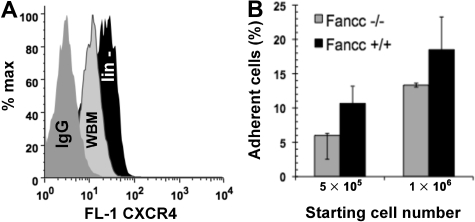To the editor:
We read with interest the article by Zhang and colleagues comparing progenitor colony formation, chimerism after xenotransplantation into immunodeficient mice, and adhesive properties of whole bone marrow (WBM) cells from Fanconi anemia (FA) patients and healthy donors.1 We applaud the study of this important topic, but would caution that assays of clonogenicity and hematopoietic repopulation are not sufficiently specific measures of homing. In fact, both are inherently skewed by the complex phenotype of FA hematopoietic stem cells (HSCs), comprising exaggerated apoptotic responses, constitutive cell-cycle arrest, pronounced sensitivity to reactive oxygen species, and reduced replicative fitness.2,3 Furthermore, the ability of cells to home to the microenvironment is an attribute of primitive cells. Experimental observations in WBM cells or immortalized lymphoblasts are not always faithful reflections of stem and progenitor cell behavior.4 For example, the expression of chemokine receptor 4 (CXCR4), a key homing molecule, is selectively increased in highly enriched sca+, c-kit+, lin− (SKL) progenitors, but not in WBM from C57Bl/6 wild-type and Fancc−/− mice, a murine model of FA (Figure 1A). Indeed, we previously demonstrated only modest differences in steady-state or induced CXCR4 expression and in vitro migration among lin− progenitors from Fanc-a−/−, -c−/−, -d2−/−, and wild-type animals. Cell-surface CXCR4 expression in wild-type and Fancc−/− genotypes, respectively, was up-regulated by culture at low (1%) oxygen concentration and promoted hematopoietic engraftment.5
Figure 1.
CXCR4 expression and cell-matrix adhesion among hematopoietic progenitors from Fancc−/− mice and wild-type littermates. (A) Cell-surface expression of CXCR4 on lineage-depleted (lin−) and whole bone marrow (WBM) cells from C57Bl/6 strain mice. Assay carried out as described.5 Briefly, cells were harvested from Fancc+/+ and Fancc−/− (not shown) animals, samples were depleted of red cells by hemolysis and lineage-depleted using an Easy Sep Mouse Hematopoietic Progenitor Cell Enrichment kit (StemCell Technologies, Vancouver, BC) according to the manufacturer's instructions. Samples were stained with antibodies (fluorescein isothiocyanate [FITC] label) directed against surface CXCR4 epitopes or IgG (FITC; all BD Biosciences, San Jose, CA). Expression was analyzed using a FACSCalibur (BD Biosciences) and data were processed using FlowJo software (TreeStar, Ashland, OR). (B) Cell-matrix adhesion by WBM progenitors from Fancc−/− and wild-type animals. The assay was performed using lineage-depleted progenitor cells generated as outlined above and was otherwise performed exactly as described by Zhang.1
By comparison with repopulation studies, adhesion assays provide a much more restrictive measure of cellular function and our experiments in Fancc−/− and wild-type WBM cells confirm the deficiency in cell-matrix adhesion observed by Zhang et al in FA patient WBM cells (Figure 1B). The authors associate this phenotype with reduced cdc42 activity in FA lymphoblasts. However, others previously showed that latent Epstein-Barr virus (EBV) membrane protein 1 activates cdc42 through a mechanism that mimics tumor necrosis factor α activity.6 Could discrepant cdc42 activity be related to differential responses by FA cells to EBV immortalization? Cell type–specific effects of cdc42 inactivation not only impact adhesion, but also promote cell-cycle acceleration as well as increases in progenitor frequency and clonogenicity.7 How can this be reconciled with the FA-specific G2 arrest, reduced colony formation, and poor progenitor mobilization?3,8
It is tempting to conclude that defective adhesion of FA WBM cells and decreased cdc42 activity in FA lymphoblasts imply deficient homing. A systematic, cell type–specific analysis may yet reveal such deficiencies, but the data by Zhang do not provide specific evidence for defective homing, nor a direct correlation with cdc42 activity in FA-HSC. By contrast, regulation of CXCR4 in enriched progenitors from Fancc−/− mice appears intact and, if confirmed in patient cells, could be therapeutically exploited to offset repopulation deficits.5,8 Much like an appreciation of FA protein involvement in DNA repair has produced general insight into molecular mechanisms of cancer, a nuanced evaluation of HSC deficiencies stands to yield broadly applicable gains in understanding hematopoietic failure.
Authorship
Conflict-of-interest disclosure: The authors declare no competing financial interests.
Correspondence: Peter Kurre, MD, 3181 SW Sam Jackson Park Rd, Oregon Health & Science University, Papé Family Pediatric Research Institute, L499, Portland, OR 97239; e-mail: kurrepe@ohsu.edu.
References
- 1.Zhang X, Shang X, Guo F, et al. Defective homing is associated with altered Cdc42 activity in cells from patients with Fanconi anemia group A. Blood. 2008;112:1683–1686. doi: 10.1182/blood-2008-03-147090. [DOI] [PMC free article] [PubMed] [Google Scholar]
- 2.Aube M, Lafrance M, Charbonneau C, Goulet I, Carreau M. Hematopoietic stem cells from fancc(−/−) mice have lower growth and differentiation potential in response to growth factors. Stem Cells. 2002;20:438–447. doi: 10.1634/stemcells.20-5-438. [DOI] [PubMed] [Google Scholar]
- 3.Fagerlie S, Lensch MW, Pang Q, Bagby GC., Jr The Fanconi anemia group C gene product: signaling functions in hematopoietic cells. Exp Hematol. 2001;29:1371–1381. doi: 10.1016/s0301-472x(01)00755-x. [DOI] [PubMed] [Google Scholar]
- 4.Kollet O, Spiegel A, Peled A, et al. Rapid and efficient homing of human CD34(+)CD38(−/low)CXCR4(+) stem and progenitor cells to the bone marrow and spleen of NOD/SCID and NOD/SCID/B2m(null) mice. Blood. 2001;97:3283–3291. doi: 10.1182/blood.v97.10.3283. [DOI] [PubMed] [Google Scholar]
- 5.Skinner AM, O'Neill SL, Grompe M, Kurre P. CXCR4 induction in hematopoietic progenitor cells from Fanca(−/−), -c(−/−), and -d2(−/−) mice. Exp Hematol. 2008;36:273–282. doi: 10.1016/j.exphem.2007.11.006. [DOI] [PMC free article] [PubMed] [Google Scholar]
- 6.Puls A, Eliopoulos AG, Nobes CD, Bridges T, Young LS, Hall A. Activation of the small GTPase Cdc42 by the inflammatory cytokines TNF(alpha) and IL-1, and by the Epstein-Barr virus transforming protein LMP1. J Cell Sci. 1999;112(Pt 17):2983–2992. doi: 10.1242/jcs.112.17.2983. [DOI] [PubMed] [Google Scholar]
- 7.Yang L, Wang L, Geiger H, Cancelas JA, Mo J, Zheng Y. Rho GTPase Cdc42 coordinates hematopoietic stem cell quiescence and niche interaction in the bone marrow. Proc Natl Acad Sci U S A. 2007;104:5091–5096. doi: 10.1073/pnas.0610819104. [DOI] [PMC free article] [PubMed] [Google Scholar]
- 8.Pulliam AC, Hobson MJ, Ciccone SL, et al. AMD3100 synergizes with G-CSF to mobilize repopulating stem cells in Fanconi anemia knockout mice. Exp Hematol. 2008;36:1084–1090. doi: 10.1016/j.exphem.2008.03.016. [DOI] [PMC free article] [PubMed] [Google Scholar]



